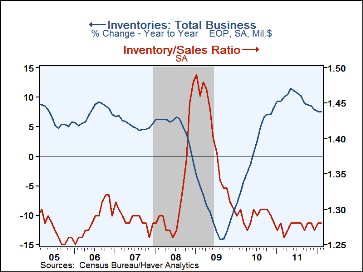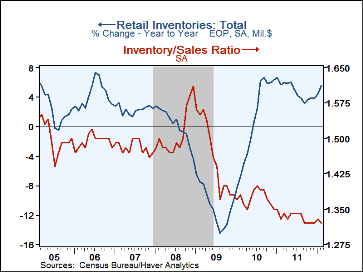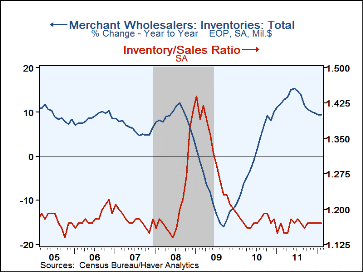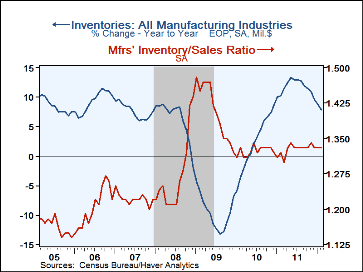 Global| Apr 16 2012
Global| Apr 16 2012U.S. Business Inventory Growth Is Moderate; I/S Ratio Near Record Low
by:Tom Moeller
|in:Economy in Brief
Summary
The U.S. Commerce Department reported that business inventories rose 0.6% during February following an upwardly revised 0.8% January gain. Business sales increased a moderate 0.7% after a 0.4% January rise. As a result, the [...]
The U.S. Commerce Department reported that business inventories rose 0.6% during February following an upwardly revised 0.8% January gain. Business sales increased a moderate 0.7% after a 0.4% January rise. As a result, the inventory/sales ratio held at 1.28, about where it's been for two years.
Retail sector inventories rose 0.6% due to a strong 1.8% rise (10.3% y/y) in motor vehicles. Inventories of home furnishings & appliances rose 0.2% (-0.6% y/y). General merchandise inventories were unchanged (4.3% y/y) and apparel inventories slipped 0.1% (+7.0% y/y). Wholesale inventories rose a firm 0.9% (9.3% y/y) led by a 5.6% rise (15.4% y/y) in petroleum. Less petroleum wholesale inventories rose a still-strong 0.6% (9.0% y/y). Factory inventories rose 0.4% (7.9% y/y).
The manufacturing and trade data are in Haver's USECON database. Note that in a value-added feature, the database includes series calculated by Haver database managers showing sales, inventories and I/S ratios for total business less motor vehicle dealers and related wholesale operations.
The Slow Recovery: It's Not Just Housing from the Federal Reserve Bank of San Francisco can be found here.
| Business Inventories (%) | Feb | Jan | Dec | Feb Y/Y | 2011 | 2010 | 2009 |
|---|---|---|---|---|---|---|---|
| Total | 0.6 | 0.8 | 0.6 | 7.6 | 7.9 | 8.7 | -9.3 |
| Retail | 0.6 | 1.1 | 0.5 | 5.5 | 3.8 | 6.4 | -10.0 |
| Retail excl. Motor Vehicles | 0.2 | 0.4 | 0.4 | 3.7 | 3.6 | 3.8 | -4.7 |
| Merchant Wholesalers | 0.9 | 0.6 | 1.2 | 9.3 | 9.9 | 10.1 | -11.8 |
| Manufacturing | 0.4 | 0.6 | 0.2 | 7.9 | 9.5 | 8.7 | -6.8 |
| Business Sales (%) | |||||||
| Total | 0.7 | 0.4 | 0.9 | 7.6 | 11.2 | 9.3 | -14.6 |
| Retail | 1.1 | 0.7 | 0.3 | 6.3 | 7.9 | 6.8 | -7.8 |
| Retail excl. Motor Vehicles | 0.8 | 0.9 | 1.1 | 6.4 | 7.2 | 5.7 | -5.5 |
| Merchant Wholesalers | 1.2 | 0.0 | 1.6 | 9.3 | 13.5 | 11.6 | -16.2 |
| Manufacturing | 0.1 | 0.6 | 0.8 | 7.1 | 11.3 | 8.6 | -18.5 |
| I/S Ratio | |||||||
| Total | 1.28 | 1.28 | 1.27 | 1.28 | 1.27 | 1.29 | 1.39 |
| Retail | 1.32 | 1.33 | 1.32 | 1.33 | 1.33 | 1.37 | 1.46 |
| Retail Excl. Motor Vehicles | 1.17 | 1.18 | 1.19 | 1.20 | 1.19 | 1.23 | 1.30 |
| Merchant Wholesalers | 1.17 | 1.17 | 1.17 | 1.17 | 1.17 | 1.18 | 1.31 |
| Manufacturing | 1.33 | 1.33 | 1.33 | 1.32 | 1.33 | 1.32 | 1.41 |
Tom Moeller
AuthorMore in Author Profile »Prior to joining Haver Analytics in 2000, Mr. Moeller worked as the Economist at Chancellor Capital Management from 1985 to 1999. There, he developed comprehensive economic forecasts and interpreted economic data for equity and fixed income portfolio managers. Also at Chancellor, Mr. Moeller worked as an equity analyst and was responsible for researching and rating companies in the economically sensitive automobile and housing industries for investment in Chancellor’s equity portfolio. Prior to joining Chancellor, Mr. Moeller was an Economist at Citibank from 1979 to 1984. He also analyzed pricing behavior in the metals industry for the Council on Wage and Price Stability in Washington, D.C. In 1999, Mr. Moeller received the award for most accurate forecast from the Forecasters' Club of New York. From 1990 to 1992 he was President of the New York Association for Business Economists. Mr. Moeller earned an M.B.A. in Finance from Fordham University, where he graduated in 1987. He holds a Bachelor of Arts in Economics from George Washington University.










